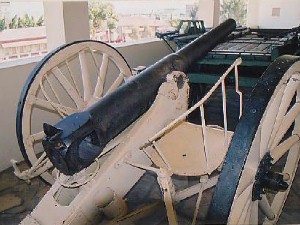 |
|
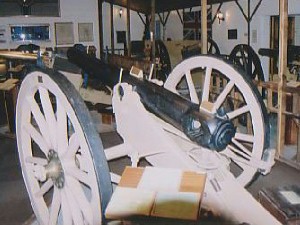 |
|
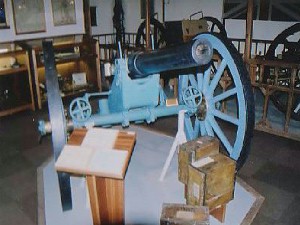 |
|
A
7.85 cm Leichte Feldgeschutz C73. This one is gun
number 89, made in 1874. Note that unlike the other C73 guns
shown on this page, this gun has seats for the gunners on the axle. It was
recovered from the lake in early 1916 and is now on display
at the Alte Fest (Old Fort) in Windhoek.
|
|
Another
7.85 cm Leichte Feldgeschutz C73. This one is gun
number 22, made in 1874. It was recovered from the lake on
30th August 1984 and is now on display at the Tsumeb Museum.
|
|
Another
7.85 cm Leichte Feldgeschutz C73. This one is gun
number 375, made in 1877. It was recovered from the lake on
30th August 1984 and is now on display at the Tsumeb Museum.
|
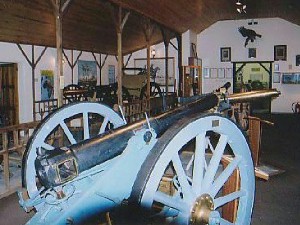 |
|
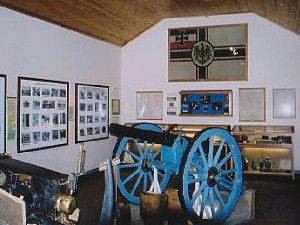 |
|
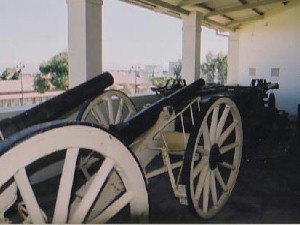 |
|
Another
view of
7.85 cm Leichte Feldgeschutz C73 Nr 375
at the Tsumeb Museum.
|
|
Another
view of
7.85 cm Leichte Feldgeschutz C73 Nr 375
at the Tsumeb Museum.
|
|
Two
7.85 cm Leichte Feldgeschutz C73s
on display at the Alte Fest in Windhoek. The one on the left
(without axle seats) is gun number 376 made in 1877. Unlike
the other guns on this page it was not dumped in Lake
Otjikoto, but was abandoned by the Schutztruppe in Windhoek
in 1915.
The gun on the right is gun number 89 as seen in the picture
on the left above.
|
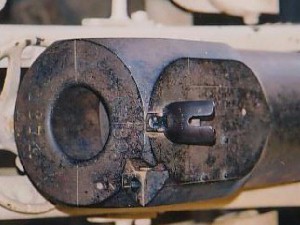 |
|
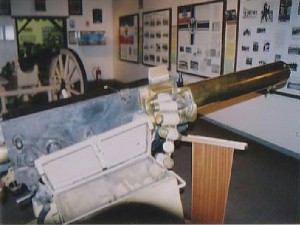 |
|
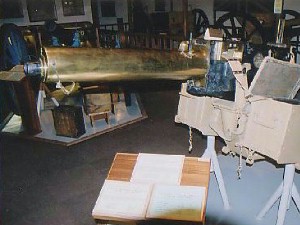 |
|
The breech of one of the
Windhoek
7.85 cm Leichte Feldgeschutz C73s. |
|
A
3.7 cm Maschinenkanone M97 Krupp type “Pom–Pom Gun”.
This one is gun number 545, made in 1903. It was recovered
from the lake on 17th January 1984 and is now on display at
the Tsumeb Museum. Another M97 Maschinenkanone, number 546
is also on display at Tsumeb, it was recovered on 17th June
1983. Of the other M97 Maschinenkanone, four were
surrendered by the Schutztruppe at Khorab in June 1915 and
are now in South
Africa (number 539 at the
Tempe Army
Base in Bloemfontein,
number 540 at the
Infantry
School at Oudtshoorn,
and numbers 542 and 543 at the
National
Museum of Military History in Johannesburg).
Another two or
possibly three are still in Lake Otjikoto. |
|
Another view of the
3.7 cm Maschinenkanone M97, number 545, on display at
the Tsumeb Museum |
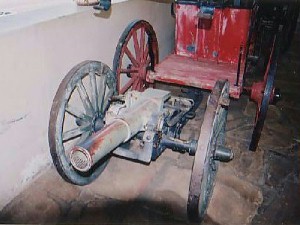 |
|
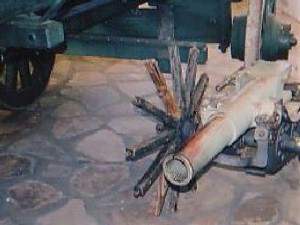 |
|
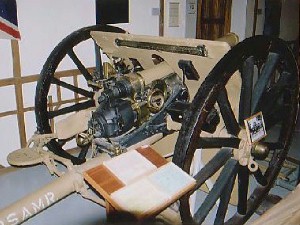 |
|
A
7.2 cm Gebirgskanone L/14 M98.
This one is either gun number 16 or 18. They were recovered
from the lake in early 1916 and were originally put on
display and used for saluting purposes at the
Tintenpalast in Windhoek. They were moved to their current
home at the Alte Fest in around 2000. Gebirgskanone number
19 is now in
the African Window Museum in Pretoria,
South Africa and another three of them are presumably still
in Lake Otjikoto.
|
|
Another
7.2 cm Gebirgskanone L/14 M98 at the Alte Fest
in Windhoek.
This one is either gun number 16 or 18. |
|
A
South
African 13 Pounder Light Field Gun (7.64 cm) made in Britain in
1913.
This one is gun number
288, named "Tulio" (after a diver who lost
his hand recovering this gun). This along with its matching
partner, gun number 289, was captured from South African
forces at the battle of Sandfontein on 23rd September 1914.
Neither of the captured guns were later used in action by
the Schutztruppe against their former owners. They were both
dumped in Lake Otjikoto in 1915, along with the other
Schutztruppe guns on this page. Gun number 288 was recovered
from the lake on 28th May 1983 and put on display at the
Tsumeb Museum as seen here.
|
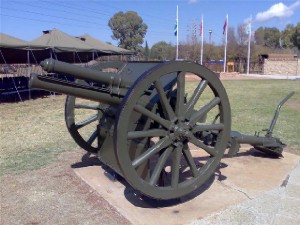 |
|
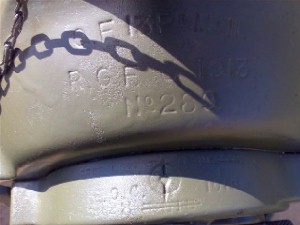 |
|
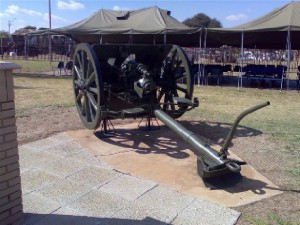 |
|
Another
South
African 13 Pdr Light Field Gun (7.64 cm) made in Britain in
1913.
This one is gun number 289. Along with gun number 288 (see
above) it was captured from the South African army at the
Battle of Sandfontein on 23rd September 1914. In 1915 along
with the other Schutztruppe guns on this page it was dumped
into Lake Otjikoto. Gun 289 was recovered by South African
forces from the lake in 1916 and went on to serve in the
South African army against the Schutztruppe of German East
Africa
and again with
the THA (Transvaal Horse Artillery) in the Rand Revolt
of 1922.
These photos of it were taken by Dominic Hoole at the
Gunners Memorial in Potchefstroom, South Africa where
it is displayed alongside gun number 205 (which was not
captured at Sandfontein). |
|
Another photo of gun number 289
taken by Dominic Hoole at Potchefstroom, showing its breech
markings with the gun number as 289 and date of manufacture as
1913. |
|
Another photo of gun number 289
taken by Dominic Hoole at Potchefstroom. |
|
|
|
|
|
|